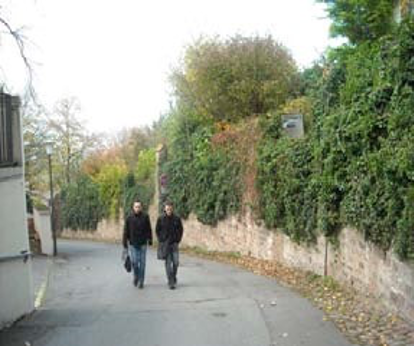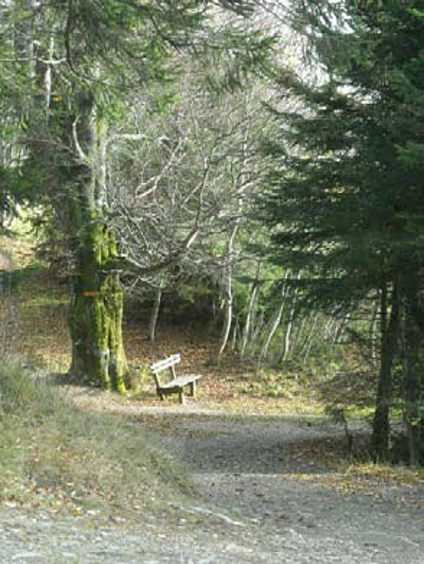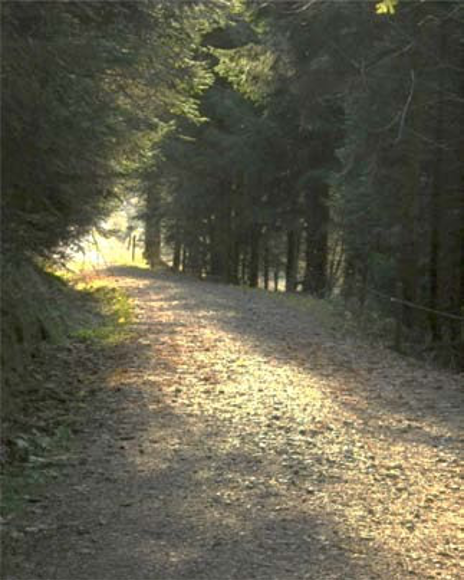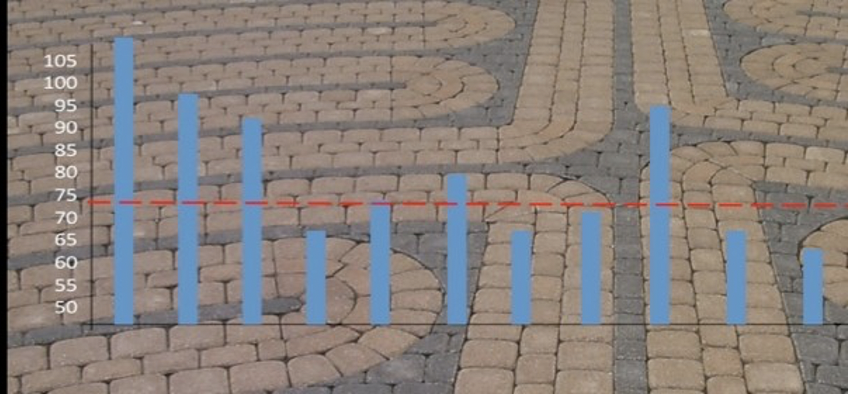Jody Rosenblatt Naderi
Ball State University, Muncie, Indiana jrnaderi@bsu.edu
Introduction
The spatial and temporal attributes of contemplative paths will be presented with a focus on landscape architectural design features. Features are identified through field observation of contemplative walking behavioral and structural path patterns. The path chosen for observation is Heidegger’s daily walking path in the Black Forest at Todtnau. It demonstrates typical characteristics of the contemplative walk. Integrating the attributes of the contemplative walk in the design of pedestrian green infrastructure supports our need to slow down, walk and think.
Contemplative Path Theory
Creative people walk to think. The place they choose impacts the outcome. Heidegger’s selection of place to think grounded his later writings. Harvard’s Leland de la Durantaye reflects on this phenomena: “… [Heidegger’s] language in Being and Time shows a preferred metaphorical register that was of the area around his hut: of forests and paths, of peaks and valleys, of dwellings and clearings, calls of nature and authentic connectedness with one’s environment. What seemed to most shape his language was the space before which I now, dirty and disoriented, stood.” (de la Durantaye). (Figure 1)

Figure1. A view across Heidegger’s path through the Todtnau valley. (photo by author)
It is common for creative people engaged in cognitively transformative experiences to walk as part of their creative act (Figure 2). The choice of contemplative path is initially spontaneous, but over time, the path emerges as a repeated route. This story is about the personal contemplative walk and its shape in the landscape, understanding the creative person’s behavior and designing accordingly.

Figure 2. The Philosopher’s Way (Filosofia Weg) near the University of Heidelberg.
Design Principles
BEHAVIOR: A contemplative walker’s behavior directs the designer. (Figure 3) The contemplative walker tilts his or her head slightly downward, resetting the cone of vision to a location closer to footfall. This increases if the person is reading. The pace is slower, repetitive and rhythmic. The hands are clasped behind the back or brush along a rail or wall to keep on track. The movement forward must be navigated with care because they aren’t paying attention to where they are going.

Figure 3. A pedestrian demonstrating the posture and position of contemplation and his response to the environment. (photo by author)
Derived from the variables positively associated with walking purpose (Naderi and Raman, 2005), the landscape measures examined in this study are associated with walking for renewal. They include accessibility, ground surface articulation, places for pause, the rhythm of the visual experience, edge and environmental complexity, occurrence and length of views from the path, the presence of infinite beauty, topography, the presence of built (historic) features, and proximity to water, rock, earth and decay.

Figure 4. The route of Heidegger is the typical loop of the contemplative walk, shown in a dashed line connecting the Fatima Chapel through the woods to Jakobs Cross and Radschert. (from Gloecklehoff pensione website)
ROUTE: Heidegger starts from his hut following a loop that goes from A to A without traveling the same footstep twice. He proceeds south towards a Chapel or west towards Jakobs Cross (Figure 4), both focal point features consistent with the alignment of contemplative paths worldwide. The loop configuration has a main spine and a minor path for the return that links religious chapels and various monuments. The process of following a continuum rather than retracing supports an important part of the contemplative walk preference.

Figure 9. Bench along the Martin Heidegger Weg. (photo by the author)
PROSPECT: The experience along these paths includes views of great beauty or views of infinity. Metaphorically, these vistas are critical in any hunt, providing the hunter with an expanded view of the “potential prey” while protecting them from attack (Appleyard, 1975). A strategic bench, stump or other type of seating (Figure 9) facilitates the “aha” moment.

Figure 10. Spatial analysis of Katara’s Philosopher Walk in Kyoto. (analysis by author)
PROPORTION: Openings along the path are found to be coincident with perfectly framed views of the Neckar in Heidelberg, infinite views into the Alps around Todtnau, the golden temples of Ginkakuji in Kyoto and, in Copenhagen, with the statue of Hans Christian Anderson. The presence of perfect proportion in the shape of the path itself repeats in each of the locations studied (Figure 10). Cross-sectional path features consistently express a proportion between 1.6 and 2.0, resonant with a sense of perfect human scale and beauty. The paths are often ledges, underscoring the archetype of a transformative experience between earth and sky.

Figure 11. Heidegger’s path cut as a ledge in the forest. These paths were groomed to keep access throughout the summer and ski season in the Alps. (photo by author)
COMPLEXITY: The outcome from the field work indicates that path complexity exists to support contemplation by presenting as simple at the forest scale and yet highly complex at the micro scale of an individual tree. This duality – highly complex elements juxtaposed with simple elements – is a signature characteristic of the contemplative path and supports introspection. Edge complexity is a significant variable in making a decision regarding wayfinding as well as ecological comfort (Appleyard, Lynch, Zube, Forman, etc.) and the route of the contemplative walk is not exempt. In Heidegger’s path, one side is at eye-level with the decay and transformation of exposed root zone, the other side is up into the first tier of the grid of tree branches from the forest below (Figure 11). Theoretically, this observation may be grounded in arousal theory as follows.
Based on Berlyne’s study (Berlyne 1960) and subsequent fieldwork, the author postulated in 2008 that the most highly complex or, conversely, simple enclosures create an environment that supports or stimulates a highly contemplative state of mind (Rosenblatt Naderi, 2008, Walk21, Zurich). (Figure 12)

Figure 12. Berlyne’s study in arousal defined tolerance for complexity as a factor in level of external attention and curiosity. (graph interpretation by the author)
The complexity theory is not without example. Kierkegaard used the crowded streets of Copenhagen as part of his creative process. The walk taken by Kataro in Kyoto crossed through a market district that is highly trafficked. Heidegger himself walked in Freiburg when he was at the university, finding a path along the river to support these needs (Sharr). On the simpler side, the Salk Institute has Kahn’s sublime channel used by many for contemplation and renewal, the Chartres labyrinth is a regular pattern of repeating pavers and both Kyoto and Heidelberg example (Figure 4) employ a simple paver patterned edge along the path.
PULSE: The pulse of the walk and the landscape are instrumental in triggering the integration of the contemplative path. Design speed of the contemplative walk is important to note when developing urban infrastructure that would support this slow type of walking experience. In field studies to date (self-report in Todtnau), the contemplative walker clearly walks at a slower pace than someone commuting to get somewhere. The landscapes they follow also move at a slower pace resulting a diurnal dance of the sublime.
The pace of the contemplative walker would impact the design of pedestrian infrastructure. In the University of Guelph Arboretum, a group of graduate students engaged in pedestrian design identified their contemplative pace using a metronome. The participants walked at a pace that they self-reported as contemplative (Figure 13). The range of walking speeds is consistent with field studies conducted at locations in Kyoto and Heidelberg. The average pace is 75 beats per minute. Interestingly, this is the pulse of the resting heart.

Figure 13. Eleven participants recorded self-reported their contemplative pace in multiple locations of contemplative walk typology. (photo by author)
SYNTHESIS: From hut to chapel and on around to hut again, the looping trail of Heidegger is healing. The constant ledge of the ground plane, the opening and closing of vistas from distant mountaintop to adjacent spider web, the slap of one scale of time against another makes the mind consider and realize, all the while pushing against the slow incline of the topography. Combined with the physical health benefits of increases in serotonin, oxygenation and reduced distractions involved in concentrating on the path, the principles of the contemplative walk environment can be replicated with care.
Next Steps
Heidegger’s access to the mountain walk is a prime case study demonstrating some of the design features of the contemplative walk. As we develop green infrastructure for the new city, we must consider strategically integrating design attributes that support contemplation and renewal.
References
Abram, David (1996). The Spell of the Sensuous: perception and language in a more-than-human world. Vintage Press
Appleton, Jay (1975). The Experience of Landscape, John Wiley and Sons, NewYork.
Appleton, Jay (1984). “Prospects and refuges re-visited”. Landscape Journal, Vol. 3, No. 2 pp.91-103. Berlyne, D.E., (1960) Conflict, Arousal and Curiosity. McGraw Hill.
De la Durantaye, Leland (2007) . “Being There”. Cabinet. Issue 25 Insects, Spring
Heidegger, Martin (1945) translated by Bret Davis (2010). Country Path Conversations (Studies in Continental Thought). Indiana University Press
Quercia, Daniel. “Happy Maps”. https://www.youtube.com/watch?v=AJg9SXIcPiM , Accessed April 2 , 2015
Rosenblatt Naderi, J. and Raman, B. (2005). “Capturing Impressions of Pedestrian Landscapes Used for Healing Purposes with Decision Tree Learning.” Landscape and Urban Planning, 73: 155-166 Sawyer, R. K. (2012). Explaining Creativity: the science of human innovation (2nd ed.). New York, NY: Oxford University Press.
Sharr, A., D. Meller-Marcovicz (2006). Heidegger’s Hut, MIT Press



